(Self Study Program, It can help you analyze some Automotive Electronic part and function)


Service.
289
Self Study Programme 289
For internal use only
Adaptive cruise control in the Audi A8

Design and operation
Adaptive cruise control is a new system
designed to assist drivers and offers a much
wider range of functions than the conventional
Tempomat.
Driver convenience is considerably enhanced,
as fewer accelerator and brake pedal operations
are required. Speed restrictions and
safe distances are reliably observed and the
flow of traffic thus better regulated.
3
Contents
Page
Attention!
New! Note!
The Self Study Programme contains information on design features
and functions.
The Self Study Programme is not intended as a Workshop Manual.
Values given are only intended to help explain the subject matter
and relate to the software version applicable when the SSP was
compiled.
Use should always be made of the latest technical publications
when performing maintenance and repair work.
Introduction
Summary of adaptive cruise control . . . . . . . . . . . . . . . . . . . . . . . . . . . . . . . . . . . . . 4
Limits of adaptive cruise control system . . . . . . . . . . . . . . . . . . . . . . . . . . . . . . . . . 4
Requirements for adaptive cruise control operation. . . . . . . . . . . . . . . . . . . . . . . . 5
Radar basic principles. . . . . . . . . . . . . . . . . . . . . . . . . . . . . . . . . . . . . . . . . . . . . . . . . 6
System components
General view of vehicle . . . . . . . . . . . . . . . . . . . . . . . . . . . . . . . . . . . . . . . . . . . . . . . 14
Distance control sender G259 and distance
control unit J428 . . . . . . . . . . . . . . . . . . . . . . . . . . . . . . . . . . . . . . . . . . . . . . . . . . . . .16
Cover for distance control sender . . . . . . . . . . . . . . . . . . . . . . . . . . . . . . . . . . . . . . 17
System functions
Operation and driver information concept. . . . . . . . . . . . . . . . . . . . . . . . . . . . . . . 18
System statuses. . . . . . . . . . . . . . . . . . . . . . . . . . . . . . . . . . . . . . . . . . . . . . . . . . . . . 19
Operation and driver information . . . . . . . . . . . . . . . . . . . . . . . . . . . . . . . . . . . . . . 20
System settings . . . . . . . . . . . . . . . . . . . . . . . . . . . . . . . . . . . . . . . . . . . . . . . . . . . . . 27
Fault displays/deactivation. . . . . . . . . . . . . . . . . . . . . . . . . . . . . . . . . . . . . . . . . . . . 28
Mode of operation
General mode of operation of adaptive cruise control . . . . . . . . . . . . . . . . . . . . . 32
Status diagram . . . . . . . . . . . . . . . . . . . . . . . . . . . . . . . . . . . . . . . . . . . . . . . . . . . . . 34
Data flow
System layout . . . . . . . . . . . . . . . . . . . . . . . . . . . . . . . . . . . . . . . . . . . . . . . . . . . . . . .36
CAN data exchange. . . . . . . . . . . . . . . . . . . . . . . . . . . . . . . . . . . . . . . . . . . . . . . . . . .38
Block diagram . . . . . . . . . . . . . . . . . . . . . . . . . . . . . . . . . . . . . . . . . . . . . . . . . . . . . . 40
Service
Setting of distance control sender . . . . . . . . . . . . . . . . . . . . . . . . . . . . . . . . . . . . . 42
Diagnosis . . . . . . . . . . . . . . . . . . . . . . . . . . . . . . . . . . . . . . . . . . . . . . . . . . . . . . . . . . 43
Special tools. . . . . . . . . . . . . . . . . . . . . . . . . . . . . . . . . . . . . . . . . . . . . . . . . . . . . . . . 44
4
Introduction
Summary of adaptive cruise control
The basic adaptive cruise control function is
to maintain a driver-selectable distance from
the vehicle in front.
Adaptive cruise control thus represents the
logical next step on from the original cruise
control system.
The distance from and speed of the vehicle in
front are determined by a radar sensor. If the
distance is greater than desired, the vehicle is
accelerated until the required speed input by
the driver is achieved.
289_002

Limits of adaptive cruise control system
– Adaptive cruise control is designed to
assist the driver and is not a safety system.
It is not a fully autonomous driving system.
– Adaptive cruise control provides regulation
in a speed range of 30-200 km/h.
– Adaptive cruise control does not react to
stationary objects.
– Radar operation is impaired by rain, spray
and slush.
– Tight bends may restrict operation on
account of the limited radar detection
range.
If the distance is less than desired, the vehicle
is decelerated by reducing power, changing
gear and if necessary applying the brakes. In
the interests of ride comfort, maximum possible
braking is restricted to approx. 25 % of the
maximum deceleration potential of the brake
system (full braking).
The control action is designed to assist the
driver and thus indirectly contributes to
greater road safety.
In certain traffic situations, active braking by
the driver may still be necessary.
5
Requirements for adaptive cruise control operation
The following essential information is required for control purposes:
 Distance from vehicle in front
Distance from vehicle in front
 Speed of vehicle in front
Speed of vehicle in front

If there are several vehicles within the radar detection range at the same time,
the above information is used to select the vehicle to which control is to be related.
 Position of vehicle in front
Position of vehicle in front
289_053
289_052
289_051

289_050
6
Introduction
Distance measurement
The time between signal transmission and reception of the reflected signal components is
governed by the distance from the object concerned.

Relationship between signal propagation time and distance between transmitter/receiver and
object
Example: The distance in case B is twice that of case A.
The time required for the reflected signal to reach the receiver is twice as long
in case B as in case A.
Transmitter
Receiver
50 m
100 m
Transmitter
Receiver
289_004
A
B
Radar basic principles
The designation Radio detection and ranging
(Radar) refers to an electronic system developed
to establish the position of a given
object.
It is based on a simple principle: Electromagnetic
waves are reflected by the surfaces of
objects.
The waves returning are detected as an
"echo".
7
Frequency
(in gigahertz)
76.7
76.6
76.5
FM signal
289_005
Time
Time
Direct propagation time measurement is
extremely complicated. Use is therefore made
of indirect propagation time measurement in
the form of an FMCW (Frequency Modulated
Continuous Wave) process, in which continuously
emitted extra high frequency oscillations
with time-variable frequency are
employed as transmission signal. The frequency
variation (modulation) rate is
200 megahertz within one millisecond.
The transfer medium for this is a carrier signal
with a frequency of 76.5 gigahertz. This
method makes it possible to avoid employing
complicated direct propagation time measurement
and instead to evaluate the differences
in frequency between transmitted and
received (reflected) signal, which are easier to
determine.
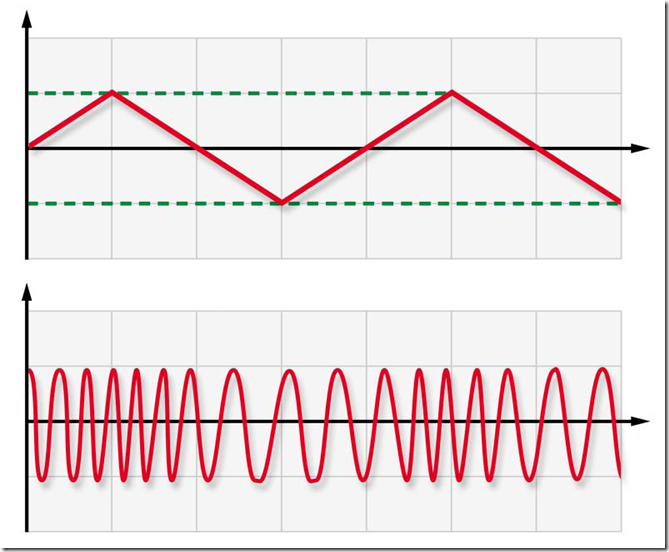
8
Introduction
The difference between the frequencies of the
transmitted and received (reflected) signal is
governed directly by the distance from the
object.
The greater the distance, the longer the propagation
time until the reflected signal is
received again and the greater the difference
between transmitted and received frequency.
Frequency
Frequency
difference
Time
difference
Transmitted signal
Received/reflected signal
Time
289_006
9
Determining speed of vehicle in front
Use is made of a physical phenomenon
known as the „Doppler effect“ to establish the
speed of the vehicle in front.
There is a basic difference depending on
whether the object reflecting the waves transmitted
is stationary with respect to the transmitter
or moving.
If the distance between transmitter and
object decreases, the frequency of the
reflected waves increases and vice versa.
This change in frequency is evaluated by the
electronics and supplies the speed value for
the vehicle in front.
Example demonstrating the Doppler effect:
As a fire engine approaches, the siren signal
sounds to be of a constantly high pitch (high
frequency).
As the vehicle moves further away, the tone
sounds lower (sudden frequency change –
lower frequency).
Pitch
289_007
MORE STUDY




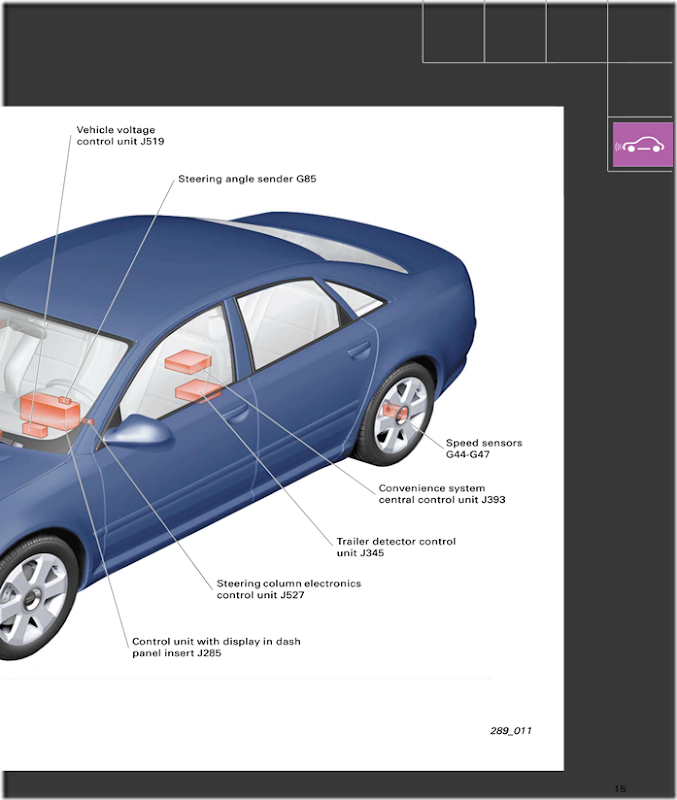

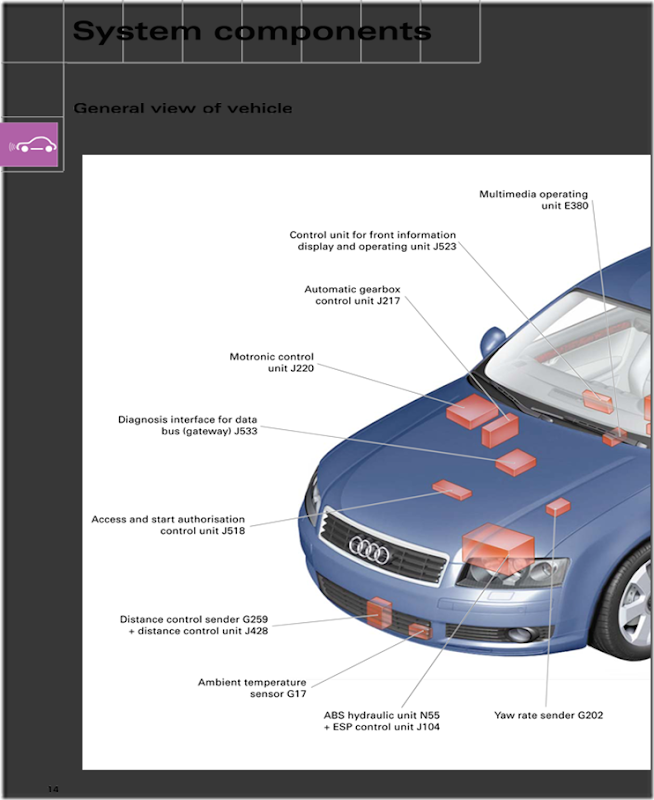

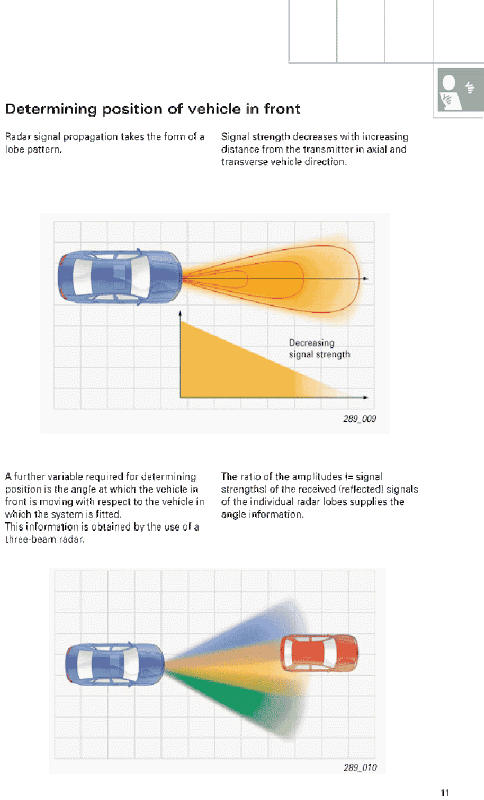














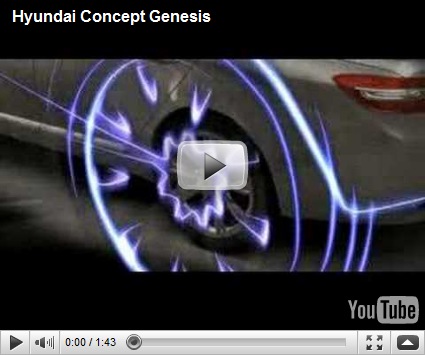


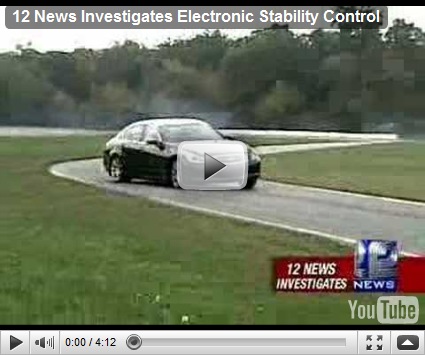
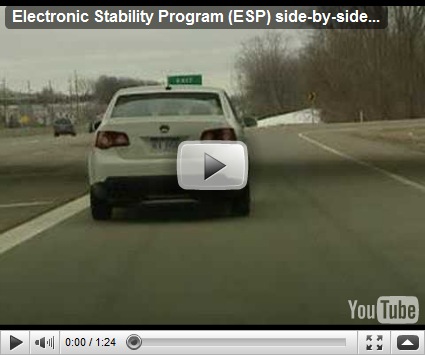







 CLICK TO VIEW GALLERY
CLICK TO VIEW GALLERY



